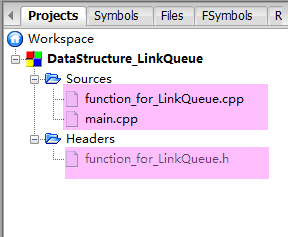文件结构:

关于头节点:
Q.head:头节点本身;
Q.head->next: 头节点的下一个节点
main.cpp:

#include <iostream> #include<stdio.h> #include<stdlib.h> #include "function_for_LinkQueue.h" using namespace std; int main() { TestLinkQueue(); return 0; }
function_for_LinkQueue.h:

#ifndef FUNCTION_FOR_LINKQUEUE_H_INCLUDED #define FUNCTION_FOR_LINKQUEUE_H_INCLUDED #define MAXSIZE 100 typedef char ElemType; //节点 typedef struct Qnode{ ElemType data; //数据域 struct Qnode *next; //指针域 }Qnode, *QueuePtr; typedef struct{ QueuePtr head; //队头指针--指向位于队头的Qnode节点 QueuePtr rear; //队尾指针--指向位于队尾的Qnode节点 }LinkQueue; //初始化 void InitQueue(LinkQueue &Q); //销毁 //从队头节点开始,依次释放所有节点 void DestroyQueue(LinkQueue &Q); //(队尾)插入元素 void InsertQueue(LinkQueue &Q, ElemType e); //(队头)出队--返回值 ElemType DelQueue_with_elem(LinkQueue &Q); //(队头)出队--不返回值 void DelQueue(LinkQueue &Q); //获取队头元素 ElemType GetHead(LinkQueue &Q); //打印队列元素--从头到尾 void PrintQueue(LinkQueue &Q); //测试 void TestLinkQueue(); #endif // FUNCTION_FOR_LINKQUEUE_H_INCLUDED
function_for_LinkQueue.cpp:

#include<stdio.h> #include<stdlib.h> #include "function_for_LinkQueue.h" //初始化 void InitQueue(LinkQueue &Q){ Q.head = (QueuePtr)malloc(sizeof(Qnode)); //分配空间,将队头、队尾指针都指向队头 Q.rear = Q.head; Q.head->next = NULL; } //销毁 //从队头节点开始,依次释放所有节点 void DestroyQueue(LinkQueue &Q){ while(Q.head != NULL){ QueuePtr p = Q.head->next; free(Q.head); Q.head = p; } printf("销毁成功 "); } //(队尾)插入元素 void InsertQueue(LinkQueue &Q, ElemType e){ QueuePtr p = (QueuePtr)malloc(sizeof(Qnode)); //新分配一个节点空间 if(!p) exit(0); //判断分配是否成功 p->data = e; //给数据域赋值 p->next = NULL; Q.rear->next = p; //关键算法 -- 可以看出,此队列存在头节点,头节点在第一个节点上,首元节点在第二个节点上 Q.rear = p; } //(队头)出队--返回值 ElemType DelQueue_with_elem(LinkQueue &Q){ if(Q.head == Q.rear) exit(0); //队列先判断是否为空 ElemType e = Q.head->next->data; QueuePtr p = (QueuePtr)malloc(sizeof(Qnode)); p = Q.head->next; Q.head->next = p->next; //考虑特殊情况,若头指针的下一个节点就是尾指针,即队列中只有一个元素 if(Q.rear == p) Q.head = Q.rear; //则头指针指向尾指针位置,即队列清空 free(p); return e; } //(队头)出队--不返回值 void DelQueue(LinkQueue &Q){ if(Q.head == Q.rear) exit(0); //队列先判断是否为空 QueuePtr p = (QueuePtr)malloc(sizeof(Qnode)); p = Q.head->next; Q.head->next = p->next; //考虑特殊情况,若头指针的下一个节点就是尾指针,即队列中只有一个元素 if(Q.rear == p) Q.head = Q.rear; //则头指针指向尾指针位置,即队列清空 free(p); } //获取队头元素 ElemType GetHead(LinkQueue &Q){ if(Q.head == Q.rear) exit(0); //判空 return Q.head->next->data; //队列头节点不存放元素,首元节点在第二个节点 } //打印队列元素--从头到尾 void PrintQueue(LinkQueue &Q){ if(Q.head == Q.rear) exit(0); //先判空 QueuePtr p = Q.head->next; //建立游标指向首元节点 do{ printf("%c ", p->data); //依次输出每个元素的数据域 p = p->next; //游标后移 }while(p); } //测试 void TestLinkQueue(){ LinkQueue Q; printf(" 初始化: "); InitQueue(Q); printf(" 插入元素a,b,c,d,e(队尾): "); InsertQueue(Q, 'a'); InsertQueue(Q, 'b'); InsertQueue(Q, 'c'); InsertQueue(Q, 'd'); InsertQueue(Q, 'e'); printf(" 获取队头元素:%c ", GetHead(Q)); printf("打印队列: "); PrintQueue(Q); // printf("获取队头元素:%c ", GetHead(Q)); // printf("打印队列: "); // PrintQueue(Q); printf(" 再次从队尾插入元素: "); InsertQueue(Q, 'f'); // printf("获取队头元素:%c ", GetHead(Q)); printf("打印队列: "); PrintQueue(Q); printf(" 此时头节点的next指向的节点的数据域是:%c ", Q.head->next->data); printf(" 出队: "); DelQueue(Q); printf("获取队头元素:%c ", GetHead(Q)); printf("打印队列: "); PrintQueue(Q); printf(" 出队并返回队头元素:%c ", DelQueue_with_elem(Q)); printf("获取队头元素:%c ", GetHead(Q)); printf("打印队列: "); PrintQueue(Q); printf(" 销毁节点: "); DestroyQueue(Q); printf("获取队头元素:%c ", GetHead(Q)); printf("打印队列: "); PrintQueue(Q); }
运行结果:

